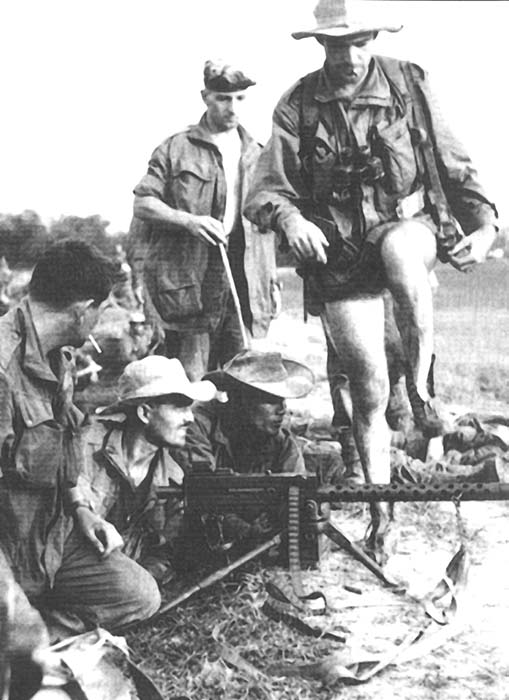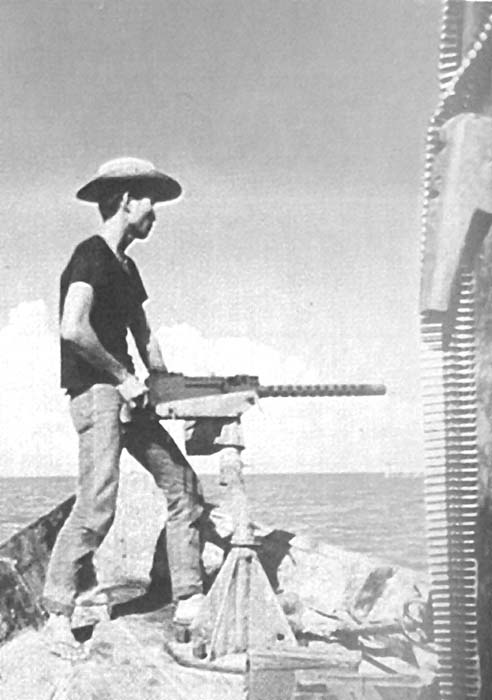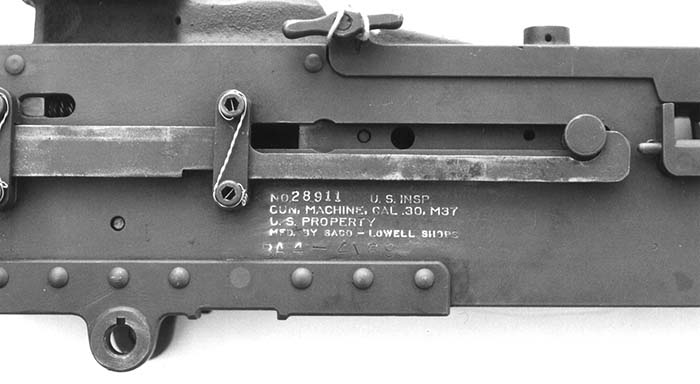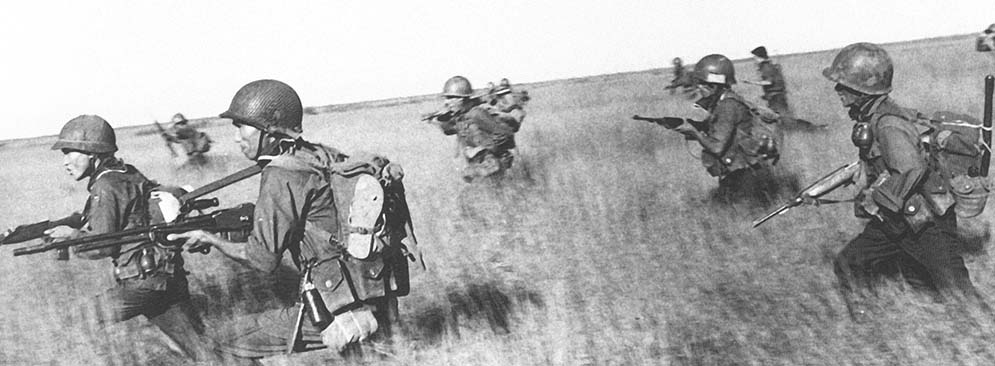By Frank Iannamico
Lead Photo: A squad of South Vietnamese troops patrol armed with a number of U.S. manufactured WWII weapons, including a BAR and M1 carbines. The soldier at the center of the photograph is carrying a 1919A4 machine gun on his shoulder.
While the U.S. 7.62 M60 General Purpose Machine Gun was the most prevalent weapon of its type used during the Vietnam War, it fought alongside a seasoned veteran. The old soldier sharing the machine gun role was the venerable Browning 1919A4 and 1919A6. Early in the war both the 30’06 caliber 1919A4 and 1919A6 machine guns were used by U.S. troops, but as more M60s became available the old workhorse 1919’s were turned over to the South Vietnamese Government. Vietnam was the fourth major U.S. conflict that the old Browning design served in. Ironically enough the M60 GPMG shared many traits of the Browning’s old adversary in WWII, the German MG42 machine gun.
The Browning 1919A4 and 1919A6 machine guns both had their origins in WWI. When the United States entered the First World War on April 6, 1917 the U.S. Army had approximately 1,100 various Maxims, Benet Mercies, and Model ’95 Colt machine guns in its inventory. For a country that was entering a major war being fought with machine guns, the United States’ situation was critical. The same shortage was also faced in virtually all other areas of equipment and weapons.
John Browning first demonstrated his latest water-cooled machine gun in February of 1917. The demonstration was witnessed by many senators, congressman and high-ranking military officers, as well as representatives from many friendly foreign armies. In the months following the demonstration, Mr. Browning continued working to improve his machine gun. In May of 1917 his weapon was again tested at the government proving ground located at the Springfield Armory. Its performance in the test was nothing short of amazing. At a cyclic rate of over six hundred rounds per minute, 40,000 rounds were fired without a malfunction. The results of this test attracted interest as well skepticism. To quell any doubts of the gun’s worth, another test was scheduled for the weapon. In the second test, the gun was fired by Mr. Browning for 48 minutes straight with no malfunctions or stoppages. Duly impressed, the board of five U.S. Army officers who witnessed the testing recommended the weapon for immediate adoption. Unfortunately few of the Browning machine guns made it to Europe before the war ended.
At the conclusion of World War One in 1918, the United States Army had approximately 140,000 machine guns in its inventory. The conservative U.S. Army of the day felt no need for additional weapons. In the years following the war, the various machine guns like the Lewis, Vickers, Marlin and others were one by one declared obsolete. The U.S. Army did however kept the weapons in storage in the event of emergency. By the 1930’s only the Browning model remained as the United States’ standard machine gun.
The Ordnance department was pleased with the model 1917 machine gun, but realized that they needed a more compact machine gun for its fledgling tank corps. The liquid cooled Browning 1917 was simply too large and cumbersome for the job. Browning went to work to design an air-cooled version, the result was the Caliber .30, Tank Machine Gun Model of 1919. The Army also desired an air-cooled variation as a “Light Machine Gun” for infantry and cavalry units. Several modifications to the 1919 “Tank” gun were made eventually resulting in the Model of 1919A4 “Light” Machine Gun. Prior to WWII, the air-cooled .30 caliber Browning machine gun had only existed in blueprints and in a few hand built models at the Rock Island Arsenal.
During WWII, the Browning 1919A4 was considered the “light” machine gun of the United States Army. Its official nomenclature was the Machine Gun, caliber .30, H.B. M1919A4 (H.B. for heavy barrel). The weapon was air cooled, recoil operated and belt-fed. The receiver of the 1919A4 for all practical purposes was the same as the earlier “Heavy” Browning Machine Gun, the water cooled 1917 series.
The 1919A4 machine gun was utilized as a direct fire weapon, designed to deliver automatic fire at close and mid-ranges. Because it was considered a support weapon it was to be kept well forward so that the crew could see both their targets and the location of their own front lines. The flat trajectory of the light machine gun was highly destructive against unsheltered enemy troops, and when well directed, could inflict heavy casualties. When used against a well dug-in enemy the weapon had little effect except to neutralize their fire and pin them down.

Principle of Operation
In a recoil operation weapon, the rearward force of the expanding powder gases is utilized to mechanically perform the operations of; unlocking the breech, extracting and ejecting empty cartridge cases and feeding a fresh round, as well as cocking, locking and firing. The air cooling system was less efficient making the 1919A4 less capable of rapid, sustained fire than the water-cooled 1917. The air-cooled heavy barrel could keep the A4 weapon at operating temperature for approximately 30 minutes at a rate of fire of about 60 rounds per minute. A rate of approximately 150 rounds per minute could be maintained for about 15 minutes, but faster rates of fire could only be maintained for short periods. The 1919A4 had a heavier barrel than the 1917 to aid in heat dissipation.
Mounting
The 1919A4 light machine gun was mounted on the M2 tripod. The tripod design provided a stable platform and gave maximum strength and rigidity for its light weight. The tripod consisted of three tubular steel legs, articulating in a tripod head, the two rear legs being joined and supported by a traversing bar forming an “A” truss and serving as a rear support for the mounted gun. The tripod head and short front leg provided frontal support. Although the M60 had its own tripod mount, the M122, it could also be used with the earlier M2 tripod by use of a special adapter. The M122 was essentially the older M2 with upgrades.

The 1919A4 light machine gun was considered a rifle company weapon. Its crew could maintain the march rate of a rifleman, but could not move as fast as the individual rifleman. It could deliver a large, rapid volume of fire with good accuracy. It was well suited for support of attacking infantry units by flanking action, and in defense it could supplement the heavy machine gun.
While the 1919A4 was successful in its intended role, a more portable weapon was desired to fill the gap between the Browning Automatic Rifle (BAR) and the tripod mounted 1919A4. The Ordnance department decided to modify the 1919A4 as an expedient solution to the problem. As is the case with most adaptations of existing weapons, the resulting 1919A6 model was less than ideal for the task it was intended to perform.
The 1919A6 Machine Gun
The new version of the 1919A4 was designated as the Browning Machine gun, Caliber .30, M1919A6. The weapon was equipped with a light bipod assembly attached to the front barrel bearing, and a shoulder stock that was attached to the buffer tube. The weapon was capable of delivering rapid automatic fire. The gun was designed primarily as an offensive weapon, and was most effective in employing direct fire against enemy personnel and unarmored vehicles. Its high mobility and low relief adapted it to front-line missions and enabled it to accompany the attacking echelon. At midranges, when mounted on the M2 tripod, its accuracy was approximately that of the heavy machine gun. Its most important characteristic as compared with the heavy machine gun, was its superior mobility, which made it a suitable weapon for use in the rifle company. This advantage, however, was obtained at the cost in the efficiency of the cooling system. The 1919A6 had a lighter barrel than the 1919A4, consequently its rate and length of fire was limited by its tendency to overheat. Although it could fire indefinitely at the slow rate of fire of approximately 40 rounds per minute, it could maintain a medium rate of about 75 rounds per minute from 25 to 30 minutes. At a rapid rate of 150 rounds per minute it begins to overheat after about five minutes firing.

Flash Hider
The function of the flash hider M7, was to conceal the weapon’s muzzle flash, as well as ensure ample recoiling when the weapon was fired at angles other than horizontal. Accomplishing this, the weapon cyclic rate was also increased. The detachable retaining clip assembly secures the flash hider to the front barrel bushing. Therefore when a portion of the expanding powder gases are trapped in the chamber of the flash hider, the rearward force was exerted on the front of floating barrel to aiding in its recoil.
Bipod mount
The A-6 weapon was equipped with a bipod assembly that was attached to the front barrel bearing and was held in place by a lock ring. The bipod legs could be folded back alongside the barrel, or placed in a position at right angles to it. Each leg had a sliding leg that could be pulled out to raise the position of the muzzle. A wing nut and clamp were mounted on the sliding leg assembly, to permit adjustment of bipod legs with one hand. The bipod head rotated around the bearing so that the gun would not be canted when on a slope. The bipod legs were constructed to remain in a position that was vertical or parallel to the barrel when clamped in place. The sliding legs were clamped in place by means of the lower thumbscrews. Fixed rest legs were attached to the bipod head for use when the legs were folded back parallel to the barrel.
The M60 General Purpose Machine Gun was adopted by the Ordnance Corps, along with the M14 service rifle in 1957. The 7.62 M60 and the M14 were intended to replace virtually all of the WWII era small arms in the U.S. inventory. Soon after the M60 was being produced in number, the Browning 1919’s began to be phased out of front line service. The M60 offered a lightweight (23.1 pounds versus the 32.5 pounds of the 1919A6 model) weapon that could be fired from its barrel mounted bipod or a tripod. It also had the desirable feature of a true quick-change barrel without the headspace adjustment procedure of the Browings. The M60 however had its share of critics and problems. The weapon was nicknamed “The Pig” by the troops.
The 1919 Browning is very popular with today’s collectors and shooters, and is available in a number of configurations. The most common 1919A4 and A6 Brownings are those that were assembled from surplus parts sets and a “new manufacture” receiver side plate. Completely original Browning machine guns can be obtained, but are difficult to locate and more expensive. Original Browning machine guns are on the BATF’s Curio and Relics list. There are also a number of semi-automatic-only models as well as non-firing display guns being produced by a number of companies.
1919A4 Light Machine Gun General Characteristics
Weight of weapon: 28 pounds
Weight of weapon with pintle and elevating mechanism: 31.25 pounds
Weight of tripod mount, M2: 14.11 pounds
Length of barrel: 24-inches
Rate of fire: 400-550 rounds per Minute
Maximum usable rate of fire: 150 rounds per minute
Sight graduated to (yards): 2400
Muzzle velocity (w / M2 ball cartridge): 2700 feet per second
| This article first appeared in Small Arms Review V5N7 (April 2002) |










